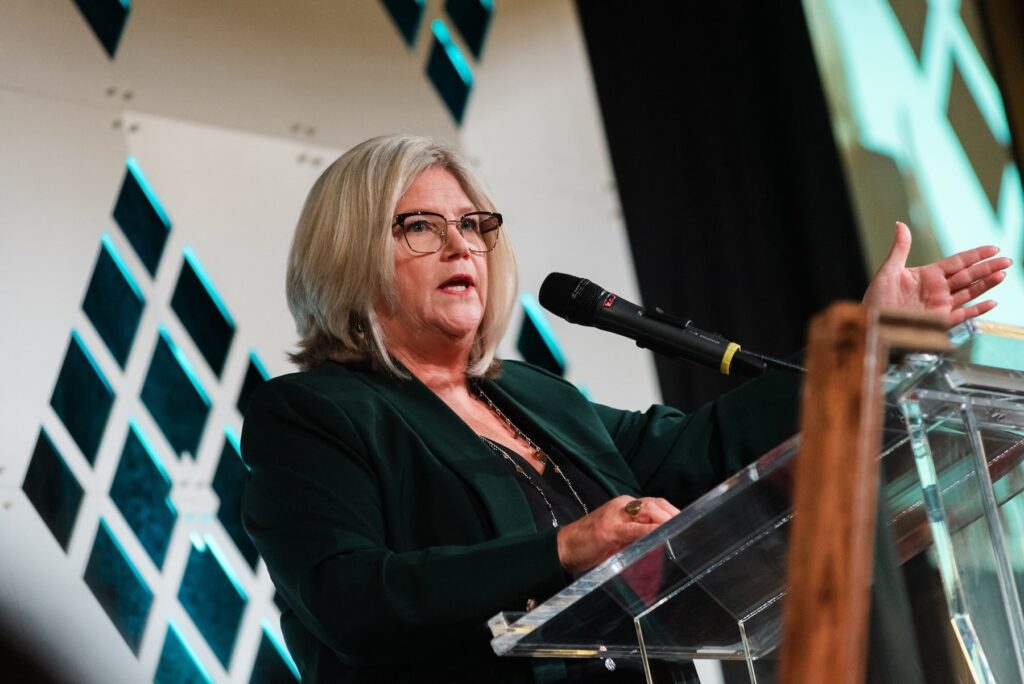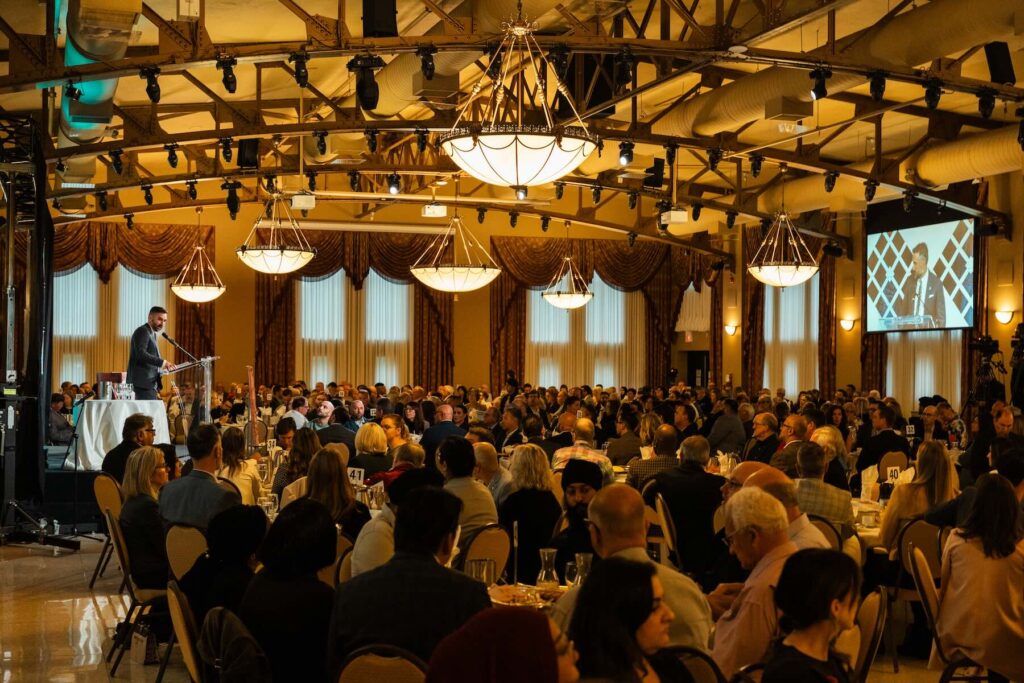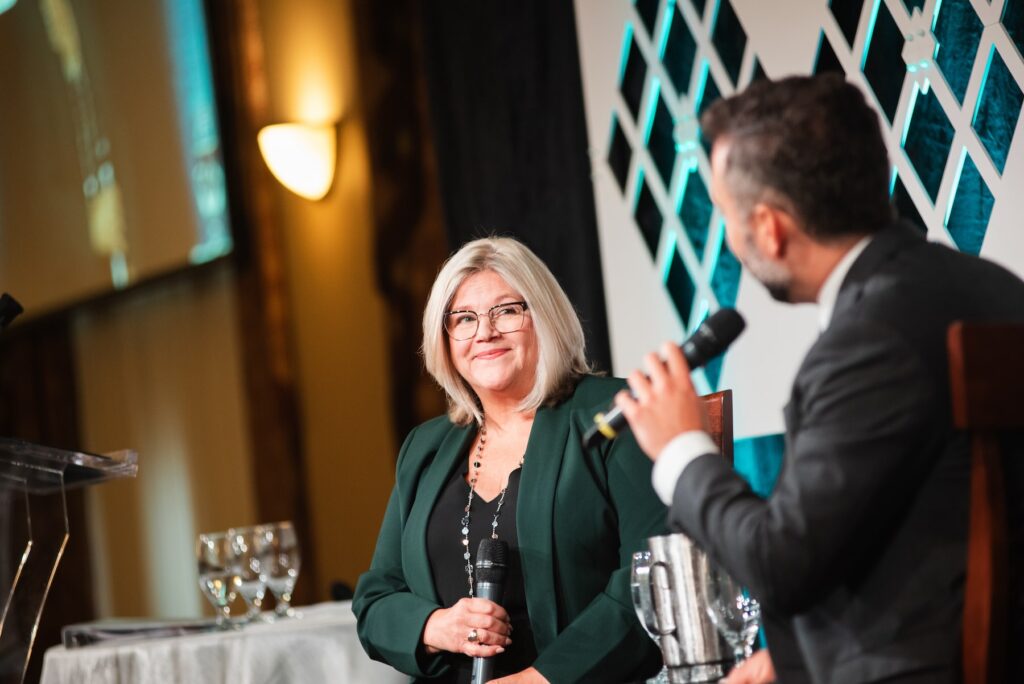Mayor Andrea Horwath urges Hamiltonians to spend time downtown

At a mayor’s breakfast event hosted by the Hamilton Chamber of Commerce, she delivered a positive but cautionary progress report on homelessness, development and growth.
A new deal for the lease of the Hamilton International Airport, a move to speed up approvals for development applications in the face of a housing crisis and a call-to-action to get all Hamiltonians behind the city’s downtown were among the key themes of the Mayor’s Breakfast event Tuesday morning.
Mayor Andrea Horwath delivered a positive rallying message while cautioning that the city faces big challenges on a number of fronts: homelessness, housing affordability and climate change being among them.
“Hope and optimism plus courage equals change, and that's where we all are right now in our city's journey,” said Horwath. It’s critical to ensure “that the rest of Ontario and Canada know what's happening in our city. We're a city on the move, and we need to tell that story.”
Greg Dunnett, president of the Hamilton Chamber of Commerce, which hosted the breakfast, said the city’s social issues and economic fortunes can’t be separated.
“When we develop solutions for challenges like homelessness, public safety, achieving NetZero, and housing affordability, we’re not just addressing community concerns – we’re actively strengthening our workforce, boosting investor confidence, and enhancing the vitality of our local economy,” he said.
“Hamilton is at a pivotal moment and the status quo is not an option. Change is inevitable, and to drive that change, we need to be adaptable, innovative, and united in our pursuit of accelerated growth.”
Flanked by a contingent of City staffers and five councillors – Tammy Hwang, Maureen Wilson, Craig Cassar, Mark Tadeson and Ted McMeekin – Horwath said she has spent the 22 months of her term making Hamilton’s case to provincial and federal cabinet ministers.
“And I can say with complete confidence that now, more than ever before, Hamilton's voice is loud. It's clear, and more importantly, we are being heard. But it never hurts to pump up the volume.”

LRT and Hamilton International Airport
Horwath urged the more than 500 leaders of businesses, anchor institutions, community organizations and non-profits who were gathered at Liuna Station to give representatives of upper levels of government “the Hamilton nudge every single time you get a chance. This is especially crucial for transformative projects like our LRT. And let me be clear, the LRT is happening, keeping this project on track is one of my top priorities.”
Horwath said LRT will drive climate goals and economic growth, help Hamilton meet its housing targets, attract investment along the route and foster a redesign of the HSR network across the city that will improve connectivity.
There was a buzz in the room when Horwath announced at Tuesday’s breakfast that the City and TradePort International Corporation had reached a new lease deal for John C. Munro Hamilton International Airport that was “10 years in the making.”
The $400 million agreement signed on Sept. 13 secures the development and expansion of the airport over a 49-year term.
SEE RELATED STORY HERE
Tents to housing
The mayor boasted about some other wins this year, including being named Municipality of the Year by Festival and Events Ontario and one of Canada’s leading investment locations by Site Selection Magazine, a series of awards for the City’s economic development team, and the groundbreaking on the redevelopment of the downtown arena.
Though building permit numbers this year won’t challenge the record set in 2023 of $2.25 billion, Horwath says “Hamilton is still buzzing with activity.”
The city has a resilient and diversified economy that will thrive and grow, she said, pointing to investments by UPS, Bartek, AstraZeneca, OmniaBio and Sucra Can Sourcing.

Photo: Sara Clausnitzer / Hamilton Chamber of Commerce
She also cited milestone anniversaries for the Hamilton Philharmonic Orchestra and the Art Gallery of Hamilton and the magnet that is Supercrawl as among the city’s key arts and cultural organizations.
But Horwath also acknowledged that many Hamilton residents don’t come downtown, and among the reasons are perceptions of it being unsafe or unclean. There are now four more police officers on the downtown core patrol team and the city’s public works department has boosted cleaning efforts such as garbage pickup and graffiti removal.
“Not only do we need to care about our downtown, we need to care for our downtown,” said Horwath. “As more people move into the core, the vibrancy will only increase, but only if we are intentional in making it a mixed income community that is a great place to live for all. I think we can do that.”
She said a welcoming and safe downtown will encourage remote and hybrid workers to come back to the office, while noting the effect of having many more people living in the core will be felt more fully as more residential buildings are occupied.
Homelessness is one of the worst crises ever faced by the city, said Horwath, noting that council will vote tomorrow (Wednesday) to ratify a plan to “bridge the gap between tents and permanent housing” while supportive housing units are built. The proposal will establish a temporary outdoor shelter site with 40 units, two common buildings, supplied food, and washrooms and laundry facilities on the Barton-Tiffany lands on the north side of Barton Street West between Caroline Street North and Hess Street North. It will also add more 192 traditional shelter beds.
Long-term initiatives include a housing investment roadmap and a housing secretariat with a dedicated focus on affordable housing. Horwath said more than 1,400 affordable housing units are shovel ready and more are in the pipeline.

She noted that while it’s a “touchy” subject, she used strong mayor powers to overturn a council vote against an affordable housing project in Stoney Creek.
The City can’t do it alone and Horwath praised the work of community housing providers such as Good Shepherd, Kiwanis, Indwell, YWCA, Sacajawea Non-Profit Housing, St. Matthew's House and CityHousing Hamilton. She shared that she hosted a summer tour for Ontario Minister of Municipal Affairs and Housing Paul Calandra to show him approved, ready-to-go housing sites awaiting provincial funding.
One of the stops was the Jamesville affordable housing site on James Street North that has sat vacant and boarded up for nearly 10 years while CN Rail has opposed redevelopment over noise and encroachment concerns. Horwath told reporters afterward that she consistently hounds CN officials but that the company is holding up development proposals in a number of municipalities that they claim will affect their operations.
The matter is set to come before a provincial tribunal next February but Horwath said it’s in the best interests of everyone that a deal be reached before that.
Streamlining development
Horwath said when she was a city councillor – she served three terms in Ward 2 starting in 1997 – she dreamed of seeing even just one crane downtown because it would mean people would be moving into core neighbourhoods. Now they dot the lower city and Horwath said she’s grateful for private developers building housing.
But she heard from many of them from the moment she took office that it’s too onerous and lengthy to get City permits and approvals. Horwath took her participation in the Bloomberg Harvard City Leadership Initiative – launched by Michael Bloomberg, the former mayor of New York City – as a chance to tackle the frustration.
She applied to be part of an innovation initiative (all of the services of the Bloomberg Harvard team was provided for free) and Horwath convened a cross-department team of City staff to participate in the mentorship and guidance of Bloomberg Harvard coaches and to consult with the development community in order to come up with creative but practical solutions.
They will be piloted in a “new, innovative development site plan process that is responsive, succinct, and will help to get housing built faster in our community,” says Horwath. It will be targeted on projects within the housing secretariat before being rolled out city-wide.
It’s necessary to fully review and evaluate applications but that can be done in a more seamless way, Horwath said after the event.
“I'm thrilled because it does a couple things. Not only does it provide some solutions that we can now pilot and hopefully implement, but also it created a space where innovation could happen in a bureaucracy like the City of Hamilton. And that's not easy to do. It's not easy to spur innovation, to create the space, to create the support and mentorship necessary to allow people to be creative and solve problems in a different way.”

‘Come downtown’
Hamilton is projected to be home to 860,000 people by 2046 and that growth poses challenges in housing affordability, improving an aging infrastructure and achieving smart growth.
“As I close I look to all of you here in this room as well and so many others to keep pushing forward, exceed expectations, be bold in your ambitions. We all know that Hamilton is the best place to live, work and play together. Let's tell the world,” she said.
“As your mayor, I'm committed to being your biggest champion and being ever present to partner and collaborate as we build this city and its future together.”
The event closed with a Q&A led by Dunnett and when asked about concerns about the fortunes of the downtown, Horwath said the pandemic and its aftermath halted great progress and she was unequivocal about what would restore it.
“We can't ever take our eye off the downtown. It's the beating heart of our city, and we have to be able to celebrate it and feel proud about it and love it each and every day, not just for the next couple of months, not just for the next couple of years, but on an ongoing basis forever,” she said.
“To the community: Come downtown, spend time downtown.”











